Waste To Fuel Technology Market Size and Trends
The waste to fuel technology market is estimated to be valued at USD 662.3 Mn in 2025 and is expected to reach USD 5,194.8 Mn by 2032, growing at a compound annual growth rate (CAGR) of 34% from 2025 to 2032.
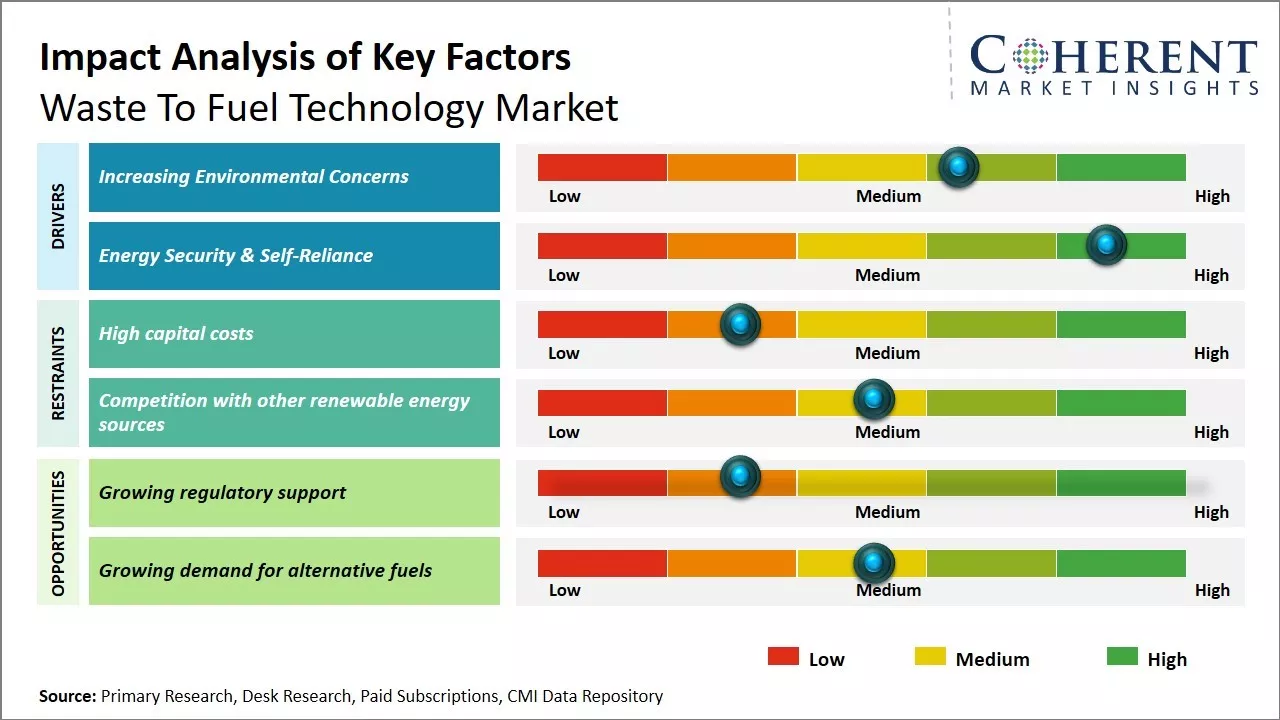
Discover market dynamics shaping the industry: Download Free Sample
The waste to fuel technology market is expected to witness significant growth over the forecast period. The growing concerns regarding greenhouse gas emissions and the increasing need to find sustainable alternatives to fossil fuels are expected to drive the adoption of waste to fuel technology. Furthermore, landfills are reaching their maximum capacities in several countries due to the huge amounts of urban and industrial waste being generated daily. This is increasing the need for scientific waste management practices and alternative solutions to process waste into reusable fuels and materials. Various government initiatives to promote the production of renewable fuels and materials from waste are also fueling the growth of this market. However, the high capital investments required for setting up waste to fuel plants may restrain the market growth.
Increasing Environmental Concerns
Increasing environmental concerns are expected to drive the market growth. For instance, Investment in Renewables and Electric Vehicles via the Inflation Reduction Act Passed in 2022 aims to cut greenhouse gas emissions by around 40% below 2005 levels by the end of the decade. It supports investments in renewable energy and electric vehicles, which are crucial components of combatting climate change. There is a growing concern amongst people and governments regarding the alarming rise in waste levels and its serious threats to the environment. Tons of garbage is ending up in landfills every day causing pollution of soil and groundwater along with emissions of methane gas which is a potent greenhouse gas. Limited landfill space in many cities and countries has emerged as a huge problem requiring innovative waste management strategies. The traditional methods of dumping, land filling, and incineration are coming under scrutiny due to various environmental hazards. At the same time, recycling has its own challenges and limits in terms of volumes handled. Waste-to-fuel technology addresses these issues by converting non-recyclable or mixed waste into a renewable source of energy in the form of refuse derived fuel, bio-fuel, or electricity. It not only diverts waste from landfills but also provides an eco-friendly way of disposing waste. This dual benefit has attracted significant interest from both public and private entities who want to proactively adopt greener solutions. Various government policies and regulations particularly in developed markets are also favoring such alternative waste treatment technologies to meet stringent emission standards and sustainability goals. As environmental stewardship gains more prominence globally, waste-to-fuel is expected to play a crucial role in powering a circular economy.
Market Concentration and Competitive Landscape
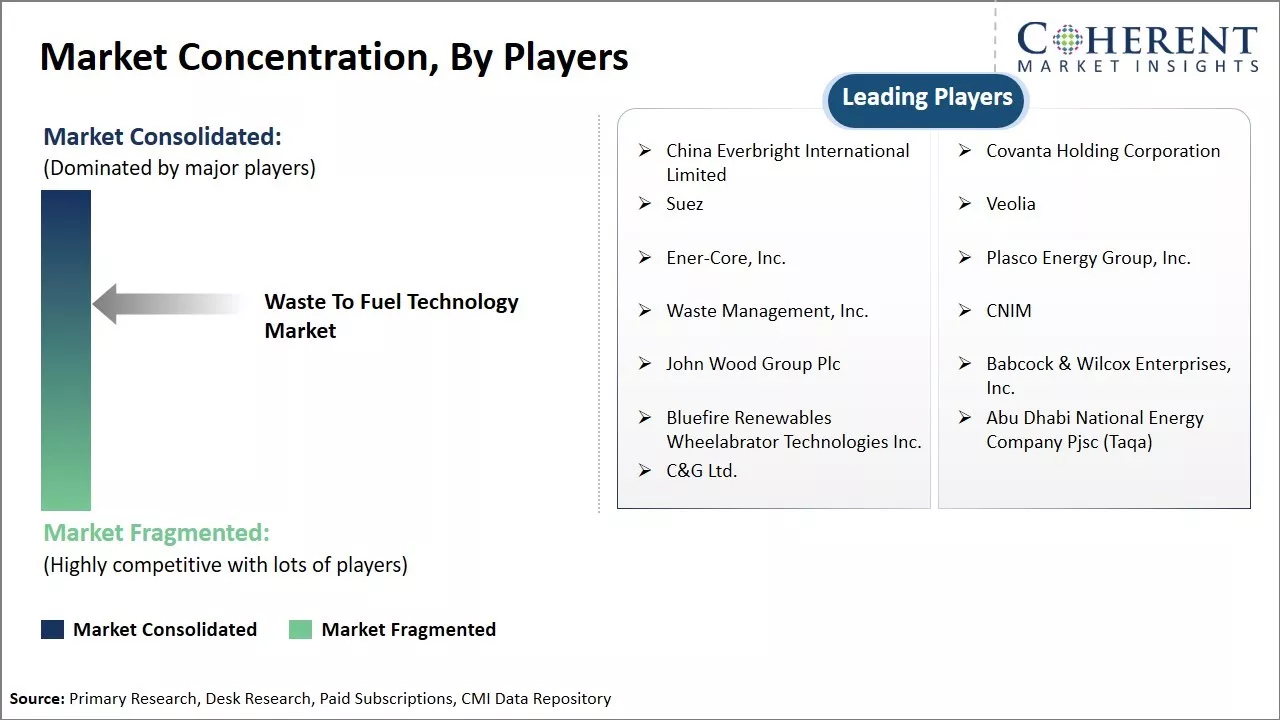
Get actionable strategies to beat competition: Download Free Sample
Energy Security & Self-RelianceMost countries import a large percentage of their primary energy requirements due to limited domestic reserves of oil, gas, and coal. This makes their energy supply vulnerable to geo-political risks and volatility in international fuel prices. There is a strong impetus therefore towards developing indigenous renewable and alternative energy sources to reduce import dependence and enhance energy security. Waste streams present a major untapped renewable resource within national boundaries that can be leveraged suitably for this purpose. Waste-to-fuel technology provides an opportunity to locally produce various forms of secondary energy carriers through proper waste treatment processes. By converting part of the urban and industrial waste generated daily into substitute fuels, valuable energy can be recovered on a consistent long term basis within the country or region itself. This supplement to primary fuel supplies boosts energy self-reliance and resilience of a location or sector. Many governments see waste-to-energy as a strategic solution that also optimizes waste management while strengthening energy security - a triple win. Hence, energy security concerns especially for fuel importing nations act as a key driver for wider adoption.
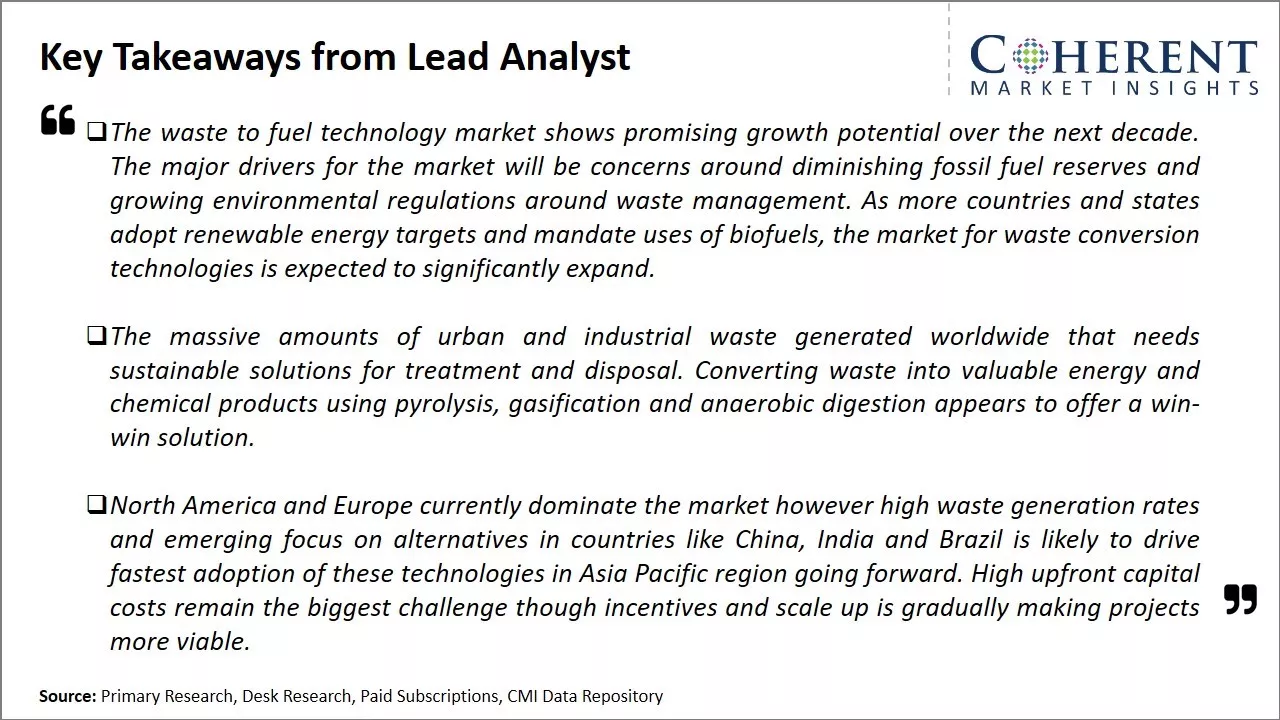
To learn more about this report, Download Free Sample
Market Challenges: High capital costsThe waste to fuel technology market currently faces several challenges. High capital costs and investment risks associated with the commercialization of new waste to fuel plants pose significant barriers. Public resistance to facility siting and concerns over emissions also remain hurdles. The heterogeneous and variable composition of municipal solid waste streams complicates fuel production processes. Separating non-biodegradable contaminants like plastics and metals increases costs. Establishing economically viable scale remains a challenge given transport costs of collecting widespread waste sources.
Market Opportunities: Growing regulatory support
The waste to fuel technology market also presents many opportunities. Globally, over 2 billion tons of municipal solid waste is landfilled or burnt each year, representing an abundant low-cost fuel feedstock. Government mandates and policies in many countries seek to decrease landfill volumes. This regulatory support drives market demand. Population growth and increasing urbanization also ensure a growing waste stream.
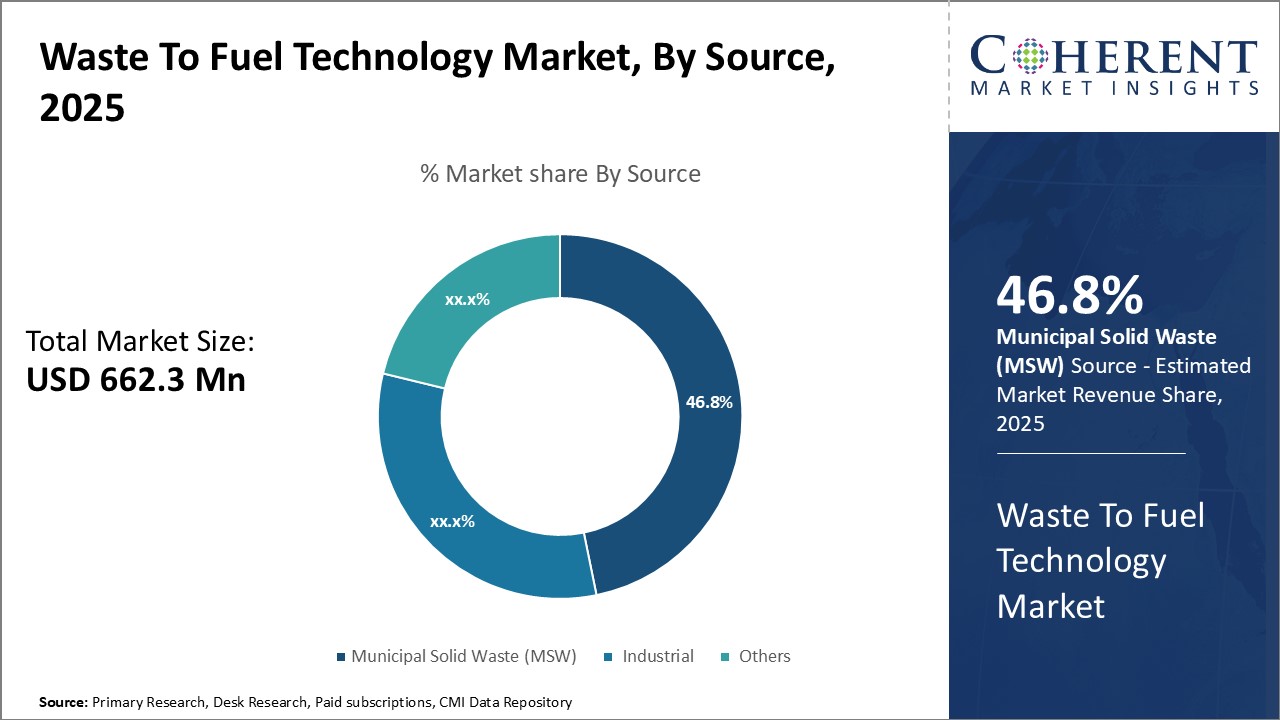
Discover high revenue pocket segments and roadmap to it: Download Free Sample
Insights, By Source: Growing Urbanization Drives Municipal Solid Waste ProductionIn terms of source, Municipal Solid Waste (MSW) contributes 46.8% share of the market owing to rapid urbanization and increasing waste generation in cities. As more people migrate to urban areas in search of employment and improved standards of living, the population of cities across the globe continues to rise exponentially. According to UN estimates, nearly 70% of the world will be living in urban areas by 2050, up from 56% today. This widespread urbanization trend results in higher waste production, as consumer lifestyles shift and consumption increases in dense urban settlements. Cities simply produce more waste per capita compared to rural regions due to factors like excessive packaging, disposability of products, and lack of proper waste management infrastructure in many developing nation cities. Municipal waste streams in cities now contain more plastics, electronics, and food waste and construction debris compared to the past.
Insights, By Depolymerization: Pyrolysis Dominates Due to its Ability to Handle Heterogeneous Waste
In terms of depolymerization, pyrolysis contributes the 41.7% share of the market owing to its ability to process mixed waste streams without significant pre-processing. Pyrolysis involves thermally decomposing organic waste like plastics, food, and yard waste in an oxygen-free environment to produce synthetic gas and bio-oil. Unlike gasification which requires rather homogeneous high calorific waste inputs, pyrolysis can efficiently convert even wet, mixed municipal waste directly into useful fuels and chemicals. It tolerates wide variations in waste composition and moisture content. This gives pyrolysis plants more flexibility to handle unpredictable incoming waste streams from municipalities, which contain diverse items. Pyrolysis also does not require as high temperatures compared to gasification, keeping capital and operating costs relatively low. Furthermore, the products obtained from pyrolysis like bio-oil have many applications as transportation fuel or in generating heat and power, giving this technology an edge over its alternatives. The versatility and low operational complexity of pyrolysis makes it the dominant depolymerization process for most heterogeneous urban and industrial waste streams.
Insights, By Fuel Type: Liquid Fuels is in High Demand
In terms of fuel type, liquid fuels contributes the 42.1% market share owing to their high energy density and compatibility with existing transport fuel infrastructure. Liquid bio-fuels obtained from waste-to-fuel technologies like pyrolysis have properties very similar to conventional fossil-derived gasoline, diesel and jet fuels. They have a higher energy density per unit volume compared to gaseous or solid fuels, making liquid fuels highly favorable for the transportation sector which accounts for a bulk of global petroleum demand. More so, the existing network of oil refineries, fuel pipelines, and distribution facilities can seamlessly blend and transport these renewable liquid fuels with minimum modifications needed. Given the pressing need to decarbonize transport and achieve higher usage of low-carbon alternatives to gasoline and diesel, liquid fuels from waste enjoy immense policy support through mandates, incentives, and subsidies in several regions. Established industrial consumers are actively procuring these waste-derived drop-in fuels to green their operations and meet sustainability targets. Overall, the strong synergies liquid fuels offer with existing fuel infrastructure and transportation applications make them the dominant output from waste-to-fuel technologies.
Regional Insights
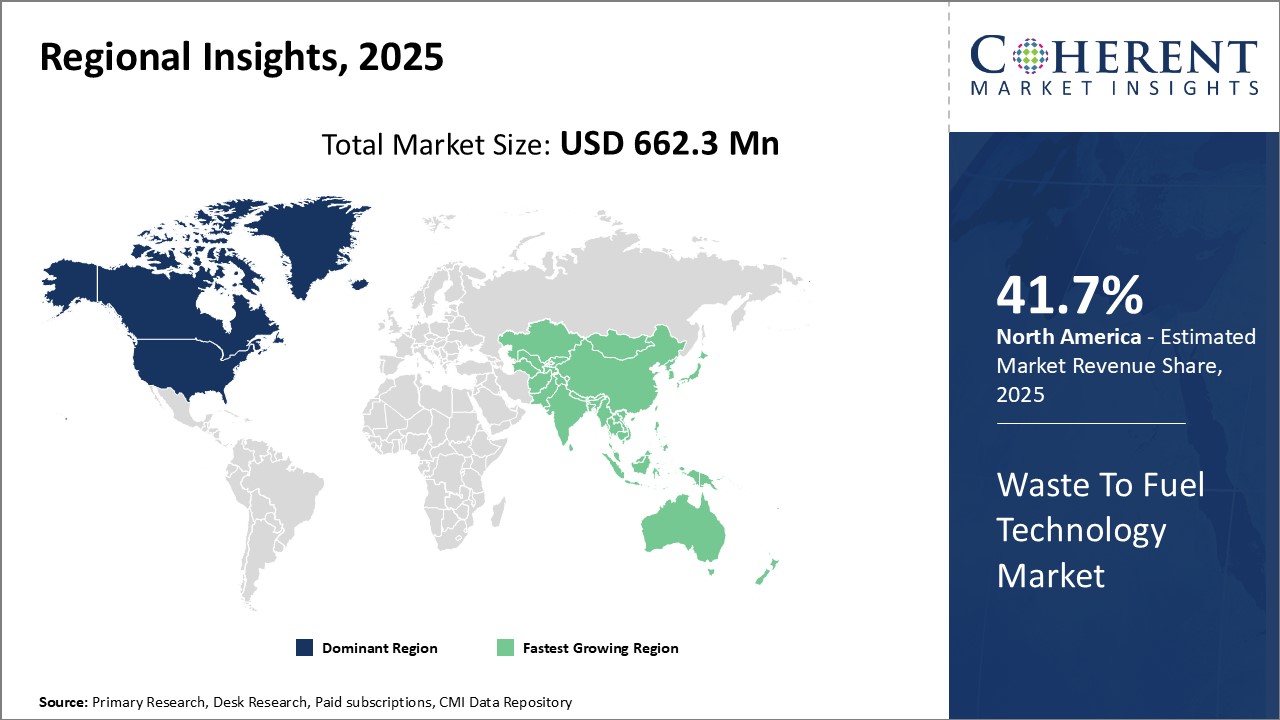
Need a Different Region or Segment? Download Free Sample
North America has emerged as the dominant region with 41.7% share in the global waste to fuel technology market. This can primarily be attributed to the presence of favorable government policies and initiatives promoting clean energy technologies. Majority of countries in the region have implemented stringent emission control regulations to minimize greenhouse gas emissions from landfills and boost the adoption of sustainable waste management practices. The U.S., in particular, has witnessed significant investments from both public and private sector players to develop advanced waste to energy facilities. MostTier-1 cities have established long-term partnerships with leading technology providers to efficiently treat their municipal solid waste. This ensures a steady feedstock supply which is critical for the financial viability of large-scale commercial projects. Additionally, provinces like California offer incentives for locally produced cellulosic biofuels encouraging regional innovation.
Asia Pacific, on the other hand, represents the fastest growing regional market driven by the tremendous capacity expansion underway in emerging economies. Countries like India, China, and Singapore are aggressively investing in futuristic technologies to address the dual challenge of limited landfill space and dependence on fossil fuel imports. Municipal bodies are collaborating with global engineering firms to harness long term revenue opportunities from waste utilization. With rising urbanization and economic growth, the demand for sustainable waste management solutions is expected to steadily escalate in the coming years. While adoption rates in Europe have been encouraging thus far, certain aspects pose unique regulatory hurdles for foreign businesses. The variable policies across nations and the lack of standardized emission guidelines necessitate bespoke system designs. On the positive side, multi-lateral initiatives like the European Bioenergy Outlook have helped establish a framework for consistent technology assessment and best-practice knowledge exchanges. Overall, the European market represents immense potential given the ambitious carbon emission goals and progressive renewable targets set by countries for next decade.
Market Report Scope
Waste To Fuel Technology Market Report Coverage
| Report Coverage | Details | ||
|---|---|---|---|
| Base Year: | 2024 | Market Size in 2025: | USD 662.3 Mn |
| Historical Data for: | 2020 To 2024 | Forecast Period: | 2025 To 2032 |
| Forecast Period 2025 to 2032 CAGR: | 34.2% | 2032 Value Projection: | USD 5,194.8 Mn |
| Geographies covered: |
|
||
| Segments covered: |
|
||
| Companies covered: |
China Everbright International Limited, Covanta Holding Corporation, Suez, Veolia, Ener-Core, Inc., Plasco Energy Group, Inc., Waste Management, Inc., CNIM, John Wood Group Plc, Babcock & Wilcox Enterprises, Inc., Bluefire Renewables Wheelabrator Technologies Inc., Abu Dhabi National Energy Company Pjsc (Taqa), C&G Ltd. |
||
| Growth Drivers: |
|
||
| Restraints & Challenges: |
|
||
Uncover macros and micros vetted on 75+ parameters: Get instant access to report
Waste To Fuel Technology Industry News
- In April 2022, Veolia unveiled two initiatives aimed at establishing local, eco-friendly, and low-carbon energy solutions. The company commenced work on the world's largest biorefinery project in Finland, which will utilize the pulp production process to generate CO2-neutral bio-methanol. Additionally, Veolia is tapping into a non-hazardous landfill in France to extract biogas for its collaboration with Waga Energy, marking the launch of the largest biomethane production unit.
- Veolia further solidified its position as a frontrunner in environmental sustainability in June 2022 by putting forth an offer for the acquisition of Suez's U.K. Waste business unit. The venture consolidates Suez's global operations with Veolia's and centers on combining resources, technologies, and expertise. The merger has already showcased its capacity to integrate new sites, capabilities, and know-how. Moreover, it will enhance Veolia's global reach, accelerate the execution of its strategic plan Impact 2023, and increase its operational capabilities.
- In April 2022, Viridor announced that its landfill and landfill gas operations would be acquired by Frank Solutions Limited, with 44 locations across the U.K. being operated and managed under the agreement. This deal enables Viridor to pursue its strategy of expanding its core business areas of energy recovery and polymer reprocessing while advancing its objective of achieving net-zero emissions by 2040.
- In June 2022, AVR announced its collaboration with Sweden's HaloSep AB to explore the potential for handling its hazardous flue gas cleaning residues within the local area. HaloSep AB's innovative process converts hazardous waste into useful and non-harmful substances. If adopted by AVR in Rotterdam, HaloSep AB's solution would enhance the plant's circularity by recovering material resources and reducing its environmental footprint.
*Definition: The waste to fuel technology market refers to the system or process of converting non-recyclable waste materials into reusable fuels like ethanol, biodiesel, or synthetic fuels. This is done through various technologies like gasification, pyrolysis, and anaerobic digestion which breakdown waste biomass and municipal solid waste to produce energy. The goal is to find high-value applications for otherwise low-value waste to reduce environmental pollution while also generating renewable and cleaner transportation fuels.
Market Segmentation
- Source Insights (Revenue, USD Mn, 2020 - 2032)
- Municipal Solid Waste (MSW)
- Industrial
- Others
- Depolymerization Insights (Revenue, USD Mn, 2020 - 2032)
- Pyrolysis
- Gasification
- Hydrogenation
- Others (Catalytic Degradation, etc.)
- Fuel Type Insights (Revenue, USD Mn, 2020 - 2032)
- Solid
- Liquid
- Gas
- Regional Insights (Revenue, USD Mn, 2020 - 2032)
- North America
- U.S.
- Canada
- Latin America
- Brazil
- Argentina
- Mexico
- Rest of Latin America
- Europe
- Germany
- U.K.
- Spain
- France
- Italy
- Russia
- Rest of Europe
- Asia Pacific
- China
- India
- Japan
- Australia
- South Korea
- ASEAN
- Rest of Asia Pacific
- Middle East & Africa
- GCC Countries
- Israel
- Rest of Middle East & Africa
- North America
- Key Players Insights
- China Everbright International Limited
- Covanta Holding Corporation
- Suez
- Veolia
- Ener-Core, Inc.
- Plasco Energy Group, Inc.
- Waste Management, Inc.
- CNIM
- John Wood Group Plc
- Babcock & Wilcox Enterprises, Inc.
- Bluefire Renewables Wheelabrator Technologies Inc.
- Abu Dhabi National Energy Company Pjsc (Taqa)
- C&G Ltd.
Share
Share
About Author
Yash Doshi is a Senior Management Consultant. He has 12+ years of experience in conducting research and handling consulting projects across verticals in APAC, EMEA, and the Americas.
He brings strong acumen in helping chemical companies navigate complex challenges and identify growth opportunities. He has deep expertise across the chemicals value chain, including commodity, specialty and fine chemicals, plastics and polymers, and petrochemicals. Yash is a sought-after speaker at industry conferences and contributes to various publications on topics related commodity, specialty and fine chemicals, plastics and polymers, and petrochemicals.
Missing comfort of reading report in your local language? Find your preferred language :
Transform your Strategy with Exclusive Trending Reports :
Frequently Asked Questions
EXISTING CLIENTELE
Joining thousands of companies around the world committed to making the Excellent Business Solutions.
View All Our Clients
